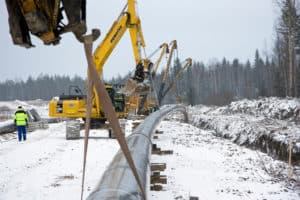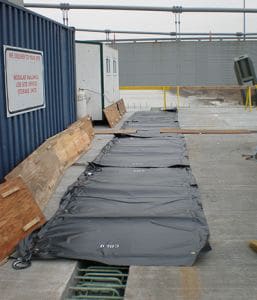In the cold winter months, extra measures have to be taken in order to ensure that construction work continues just as it does in the summer. This can be tough because extra difficulties arise, including working with frozen ground that makes digging frustrating and labor intensive. One of the best ways to combat unyielding earth is to use a ground heater.
What Are the Benefits of Using a Ground Heater?
- Extended Working Season Throughout the Winter Months
- Less Physical Strain on Workers, and Lessened Risk of Personal Injury
- Improved Ability to Stay on Track with Project Timelines
- Allows for Working With Temperamental Product (such as concrete, which must be kept at certain temperature levels in order to be successful)
What Is a Ground Heater?
Simply put, a ground heater is a tool that thaws out frozen ground, leaving it softer and much easier to work with for construction crews (or anyone else who may have a cold-weather digging project.)
There are various types of ground heaters. Two main methods many construction companies use include hydronic heaters and ground thawing blankets.
Let’s take a closer look at these options.
What Is a Hydronic Heater?
A hydronic heater is a method that utilizes:
- Boiler
- Hose
- Blower Fan
- Vapor Barrier
- Insulated Blankets
- Propylene Glycol Mixture.
Now for the steps required when using a hydronic heater:
- The hose is first laid out in loops over the entire ground area that needs to be heated.
- A boiler then heats the propylene glycol mixture until it is heated thoroughly. The mixture effectively conducts heat.
- The heated mixture is then pumped through the looped length of hose, which begins to heat the ground.
- A blower fan is used to blow the heated air across the ground to be heated.
- In order to keep moisture from escaping, a vapor barrier is used to cover the hose.
- Insulated blankets are often put over the barrier in order to ensure that no heat escapes so the ground will heat properly.
This type of heating method is beneficial in that it is flameless and provides hot, dry air to the ground that needs to be heated. Hydronic heaters can be used as a rental or purchased, depending on how much you plan to use it.
This method takes time in order to lay out the hose across the ground. As you can see, this method also requires several pieces and attachment tools.
Now let’s take a look at ground thawing blankets
What Is a Ground Thawing Blanket?
A Heated Blanket Method Utilizes:
- The Heating Blanket
- Electricity Source
Yep, that’s it!
As you can probably tell, blankets are the more simple option. Heated blankets offer all the portability and convenience of hydronic heater and then some. They take less time to install and remove, with little preparation required. They also take up quite a bit less space than hydronic heaters (with fewer parts such as attachment tools) and are easier to transport and apply to frozen ground.
Here’s how heating blankets work:
- The blanket is spread out over the area to be heated
- The blanket is plugged in to an outlet
- Electricity powers the heating elements within the blanket
Pretty easy, right?
Heated blankets typically include an insulating top layer that effectively traps heat and keeps the blanket working quickly and efficiently to quickly thaw ground, which gets your crew on the job site without delay.
Why Use Ground Heaters?
As we mentioned, one of the main reasons ground heaters are so valuable on the construction site is that frozen ground can be almost impossible to work with, even with the presence of power tools! In addition, concrete applications can take a serious pause if the correct heating tools are not in place.
If you’ve ever worked with concrete, you know that it simply cannot be poured on frozen ground. Doing so would cause the concrete to set at a temperature that is much too low, which would ultimately result in weakened concrete – up to 50 percent! Not to mention that once the ground thaws, it can cause settling that leads to eventual concrete cracks. The concrete has to be heated and cured at the correct temperature once poured as well.
Ground heaters are absolutely essential when working with concrete in the freezing winter months.
Hydronic Heaters or Heating Blankets – Which Option Is Better?
In the end, both of these ground heaters will work to get you well on your way to an easier construction project. Both methods reduce the risks of personal injury, broken tools, weakened product applications, delayed project timelines, and loads of frustration.
However, here at Powerblanket, we firmly believe that the simplest solution is often the best solution. And our customers tend to agree with us!
After all, you already have so much equipment to haul to a work site. Why complicate the process?
Choose PowerBlanket Blankets For Your Ground Thawing Needs
Our Powerblanket Ground Thawing Blankets are the simple, effective solution to your frozen ground whoas. Our simple approach to thawing frozen ground will make your projects smooth and enjoyable. Don’t let another winter storm slow down your crew’s progress. Call our experienced, friendly team today at 801.506.0198.
Time is money. Don't waste time waiting for the ground to thaw. Powerblanket has you covered.








